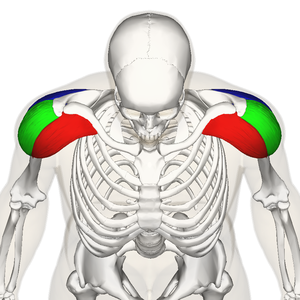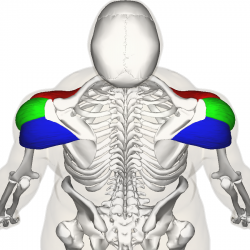ARTICLE ON HUMAN ANATOMY, MUSCLES OF THE UPPERLIMB (DELTOID MUSCLE)
INTRODUCTON
The deltoid muscle is the muscle forming the rounded contour of the human shoulder. It is also known as the common shoulder muscle, particularly in other animals such as the domestic cat. Anatomically, it appears to be made up of three distinct sets of fibers though electromyography suggests that it consists of at least seven groups that can be independently coordinated by the nervous system.
It was previously called the deltoideus (plural deltoidei) and the name is still used by some anatomists. It is called so because it is in the shape of the Greek capital letter delta (Δ). Deltoid is also further shortened in slang as "delt".
The Deltoid muscle is a large triangular shaped muscle which lies over
the glenohumeral joint and which gives the shoulder its rounded contour.
It is named after the Greek letter delta, which is shaped like an
equilateral triangle. It comprises 3 distinct portions each of which
produces a different movement of the glenohumeral joint, commonly named
the anterior, mid (or lateral) and posterior heads.
Structure
 The deltoid muscle is a rounded, triangular muscle located on the
uppermost part of the arm and the top of the shoulder. It is named after
the Greek letter delta, which is shaped like an equilateral triangle.
The deltoid is attached by tendons to the skeleton at the clavicle
(collarbone), scapula (shoulder blade), and humerus (upper arm bone).
The deltoid is widest at the top of the shoulder and narrows to its apex
as it travels down the arm. Contraction of the deltoid muscle results
in a wide range of movement of the arm at the shoulder due to its
location and the wide separation of its muscle fibers.
The deltoid muscle is a rounded, triangular muscle located on the
uppermost part of the arm and the top of the shoulder. It is named after
the Greek letter delta, which is shaped like an equilateral triangle.
The deltoid is attached by tendons to the skeleton at the clavicle
(collarbone), scapula (shoulder blade), and humerus (upper arm bone).
The deltoid is widest at the top of the shoulder and narrows to its apex
as it travels down the arm. Contraction of the deltoid muscle results
in a wide range of movement of the arm at the shoulder due to its
location and the wide separation of its muscle fibers.
The deltoid has three origins: the lateral end of the clavicle, the
acromion of the scapula at the top of the shoulder, and the spine of the
scapula. Each origin gives rise to its own band of muscle fibers with
the anterior band forming at the clavicle, the lateral fibers forming at
the acromion, and the posterior fibers forming at the spine of the
scapula. The bands merge together as they approach the insertion point
on the deltoid tuberosity of the humerus.
 The deltoid has three distinct functions that correspond to the three
bands of muscle fibers. Contraction of the anterior fibers flexes and
medially rotates the arm by pulling the humerus towards the clavicle.
Flexion and medial rotation of the arm moves the arm anteriorly, as in
reaching forward or throwing a ball underhand. The lateral fibers abduct
the arm by pulling the humerus toward the acromion. Abduction of the
arm results in the arm moving away from the body, as in reaching out to
the side. Contraction of the posterior fibers extends and laterally
rotates the arm by pulling the humerus toward the spine of the scapula.
Extension and lateral rotation moves the arm posteriorly, as in reaching
backwards or winding up to throw a ball underhand.
The deltoid has three distinct functions that correspond to the three
bands of muscle fibers. Contraction of the anterior fibers flexes and
medially rotates the arm by pulling the humerus towards the clavicle.
Flexion and medial rotation of the arm moves the arm anteriorly, as in
reaching forward or throwing a ball underhand. The lateral fibers abduct
the arm by pulling the humerus toward the acromion. Abduction of the
arm results in the arm moving away from the body, as in reaching out to
the side. Contraction of the posterior fibers extends and laterally
rotates the arm by pulling the humerus toward the spine of the scapula.
Extension and lateral rotation moves the arm posteriorly, as in reaching
backwards or winding up to throw a ball underhand.
Previous studies showed that the insertion of the intramuscular tendons of the deltoid muscle formed three discrete sets of fibers, often referred to as "heads":
- The anterior or clavicular fibers arises from most of the anterior border and upper surface of the lateral third of the clavicle. The anterior origin lies adjacent to the lateral fibers of the pectoralis major muscle
as do the end tendons of both muscles. These muscle fibers are closely
related and only a small chiasmatic space, through which the cephalic vein passes, prevents the two muscles from forming a continuous muscle mass.
- The anterior deltoid are commonly called front delts for short.
- Lateral or acromial fibers arise from the superior surface of the acromion process of the scapula.
- They are commonly called lateral deltoid. This muscle is also called middle delts, outer delts, or side delts for short.
- They are also mistakenly called medial deltoid, which is wrong, as their origin is the least medial portion of the deltoid.
- Posterior or spinal fibers arise from the lower lip of the posterior border of the spine of the scapula.
- They are commonly called posterior deltoid or rear deltoid (rear delts for short).
Insertion
From this extensive origin the fibers converge toward their insertion on the deltoid tuberosity on the middle of the lateral aspect of the shaft of the humerus;
the middle fibers passing vertically, the anterior obliquely backward
and laterally, and the posterior obliquely forward and laterally.
Though traditionally described as a single insertion, the deltoid
insertion is divided into two or three discernible areas corresponding
to the muscle's three areas of origin. The insertion is an arch-like
structure with strong anterior and posterior fascial connections
flanking an intervening tissue bridge. It additionally gives off
extensions to the deep brachial fascia. Furthermore, the deltoid fascia contributes to the brachial fascia and is connected to the medial and lateral intermuscular septa
Blood supply
The deltoid is supplied by the posterior circumflex humeral artery and the deltoid branch of the thoracoacromial artery which branches from the axillary artery.
Nerve supply
The deltoid is innervated by the axillary nerve. The axillary nerve originates from the anterior rami of the cervical nerves C5 and C6, via the superior trunk, posterior division of the superior trunk, and the posterior cord of the brachial plexus.
The axillary nerve is sometimes damaged during surgical procedures of the axilla, such as for breast cancer. It may also be injured by anterior dislocation of the head of the humerus.
Function
When
all its fibers contract simultaneously, the deltoid is the prime mover
of arm abduction along the frontal plane. The arm must be medially
rotated for the deltoid to have maximum effect. This makes the deltoid an antagonist muscle of the pectoralis major and latissimus dorsi during arm adduction.
The anterior fibers assist Pectoralis Major to flex the shoulder. The anterior deltoid also works in tandem with the subscapularis, pecs and lats to internally (medially) rotate the humerus. The lateral fibers perform basic shoulder abduction when the
shoulder is internally rotated, and perform shoulder transverse
abduction when the shoulder is externally rotated. They are not utilized
significantly during strict transverse extension (shoulder internally
rotated) such as in rowing movements, which use the posterior fibers.
The posterior fibers assist Latissimus Dorsi to extend the shoulder. Other transverse extensors, the infraspinatus and teres minor,
also work in tandem with the posterior deltoid as external (lateral)
rotators, antagonists to strong internal rotators like the pecs and
lats.
An important function of the deltoid in humans is preventing the dislocation of the humeral
head when a person carries heavy loads. The function of abduction also
means that it would help keep carried objects a safer distance away from
the thighs to avoid hitting them, as during a farmer's walk. It also ensures a precise and rapid movement of the glenohumeral joint needed for hand and arm manipulation. The lateral fibers are in the most efficient position to perform this
role, though like basic abduction movements (such as lateral raise) it
is assisted by simultaneous co-contraction of anterior/posterior fibers.
The deltoid is responsible for elevating the arm in the scapular
plane and its contraction in doing this also elevates the humeral head.
To stop this compressing against the undersurface of the acromion the humeral head and injuring the supraspinatus tendon, there is a simultaneous contraction of some of the muscles of the rotator cuff: the infraspinatus and subscapularis
primarily perform this role. In spite of this there may be still a
1–3 mm upward movement of the head of the humerus during the first 30°
to 60° of arm elevation.

Clinical significance
The most common abnormalities affecting the deltoid are tears, fatty atrophy, and enthesopathy.
Deltoid muscle tears are unusual and frequently related to traumatic
shoulder dislocation or massive rotator cuff tears. Muscle atrophy is
the result of various causes, including aging, disuse, denervation, muscular dystrophy, cachexia and iatrogenic injury.
Deltoideal humeral enthesopathy is an exceedingly rare condition
related to mechanical stress. Conversely, deltoideal acromial
enthesopathy is likely a hallmark of seronegative spondylarthropathies
and its detection should probably be followed by pertinent clinical and
serological investigation.



Post a Comment